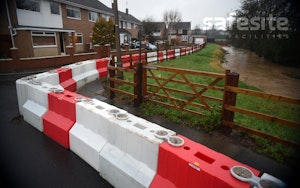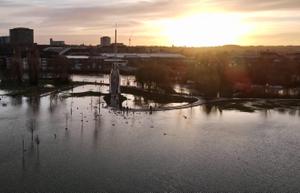- Next day delivery
- Installation service available
- Buy back on all products
- Rated Excellent
‘Prepare. Act. Survive’ – Your 3-step plan for protecting your premises from flooding
Make sure that you have everything in place to protect your premises from flooding with our 3-step planning tool.
If you know that the premises you own or manage are in an area of high flood risk, then it’s advised to have a contingency plan in place. The good news is that you need to look no further than SafeSite Facilities. We have several flood defence solutions which you can rapidly put into action. The most popular items we supply are self-filling barriers. These Flood Defence Barriers are lightweight and can be easily and quickly positioned on a flat surface. As they fill with water, the base and interlocking system strengthen. More information about this flood defence solution can be accessed here.

See here our 900mm flood barriers in place, protecting properties for a nearby river.
What do I do if the threat of flooding is imminent?
We’re mindful that you may have found this article due to a highly stressful predicament with your flood defences. For this reason, we have decided to start this article with a useful guide to quickly responding to high flood risk:
- Check the flood warning level in your area: gov.uk/check-flooding
- Prepare an emergency kit in case you need to leave quickly. Your kit should contain a mobile phone charger (and battery pack), medication, drinking water, something to wear, and/or waterproof clothing.
- Move vehicles to higher ground so they won’t be caught in rising floodwater.
- Take photos of items of value and importance around your home. This may help with insurance claims.
- Put sandbags in toilet bowls to prevent sewage backflow.
- Shut all windows and doors.
- Keep pets close by and take them when you leave
- If you need to evacuate, turn off the mains power, the floodwater can become electrocuted if the power remains on.
- Check the National Flood Forum or speak to a Floodline adviser to find out how best to stay safe, call their 24-hour service: 0345 988 1188
- Contact your local council to find where to get sandbags ��– you can also get these from DIY shops or building suppliers.
If you need immediate assistance with flood defences, then please contact our team and we will do all we can to help.

Flooded land with damage to property
If you’re in the fortunate position of having time on your hands to prepare for the eventuality of a flood, you may find the following 3-step plan useful. Those with business premises or homes at risk of flooding are encouraged to follow advice to ‘Prepare. Act. Survive’, and specifically to:
1: Research
- Gov.uk holds a wealth of information and tools to help you plan, help you during a flood, and recover after a flood. You can also view the latest river and sea levels near you and look up your property’s long-term risk of flooding.
- Sign up for advance flood warnings and view your area’s risk of flooding in the next five days.
- Check the online Flood Map for Planning tool, to research any identified flooding risk to an area, based on a postcode search. This tool is linked to the Environment Agency research and data.
- Look more closely at the flood risk to a particular property using the Gov.uk’s online service. This includes information on applying directly to the Environment Agency for data relating to a property, which can be extremely useful for insurance purposes and when deciding whether to purchase or rent a property.
2: Interpret
Understanding what the statistics or research information is telling you about your level of risk is also important. For example:
The Gov.uk postcode checker offers a clear indication of levels of risk according to zones:
- Zone 1: Low probability of river or sea flooding (less than 1 in 1,000 annually).
- Zone 2: Medium probability (between 1 in 10 and 1 in 1,000 annually for river flooding; between 1 in 200 and 1 in 1,000 annually for sea flooding).
- Zone 3a: High probability – 1 in 100 or greater annual probability of river flooding; and 1 in 200 or greater annual probability of sea flooding).
- Zone 3b: Functional Floodplain where strategic risk management and assessment is in place.
Results are offered in a visual map and text-based form, which immediately tells you the level of risk – dark blue areas of land are at risk of sea flooding) and makes it easy to tell if you are living (or proposing to live) in an area benefiting from flood defences.
The Environment Agency classifies areas with Medium and High risk of flooding, which means:
High risk: A more than 1 in 30 chance of the property being affected by flooding across one year.
Medium risk: a chance of between one in 30 and one in 100 that the property may be affected by flooding each year.
3: Take action
Once you know the level of risk to your wider area and immediate locality, it can be possible to minimise your overall risk by taking preventative action:
- Learn about flood planning for your local area (with additional research through your local council, and the Environment Agency’s flood map for planning).
- Keep checking in with the Gov.uk services, and use their online tools to monitor the risk of flooding in your area.
- You can also call the national Floodline on 0345 988 1188 or follow @EnvAgency on Twitter to keep up to date with the latest news and advice.
- If your area is suffering from flooding continue to check for further flood warnings and follow the advice of the emergency services and The Environment Agency – such as to stay away from swollen rivers and not to walk or drive through flood water as just 30cm of flowing water is enough to move a car.
- If there is a severe flood warning avoid any immediate dangers by following the advice of emergency services or calling 999 in an emergency.
- Protect your property by buying or hiring flood defences or adjusting the construction of your home. Which should you choose – sandbags or plastic flood barriers? Find out more about the best way to protect your property here.
- Check with your insurers to ensure you’re adequately covered.
- When a flood strikes sandbags and sand can be in high demand. Buy sand and provisions in place for the eventuality.
- Have an emergency kit prepared with essential items such as current phone chargers, waterproof clothing, and battery packs.
Something you may also want to consider is the threat of looting. Alarms and CCTV surveillance can act as a deterrent and capture evidence for prosecution or insurance claims. Please visit our CCTV pages or read our construction site security guide for more information.
More support
- Check the National Flood Forum or speak to a Floodline adviser, call:0345 988 1188
- Contact the Environment Agency
- Follow the UK Government’s advice on flooding
- For support, contact the British Red Cross National Support Line
Request a free no-obligation quote
We respond in under 30 mins on average (excl. weekends)